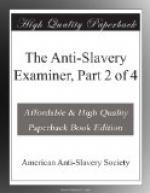[Footnote A: Of the nature of this punishment in the stocks, something may be learned by the following extract of a letter from a gentleman in Tallahassee, Florida, to the editor of the Ohio Atlas, dated June 9, 1835: “A planter, a professer of religion, in conversing upon the universality of whipping, remarked, that a planter in G____, who had whipped a great deal, at length got tired of it, and invented the following excellent method of punishment, which I saw practised while I was paying him a visit. The negro was placed in a sitting position, with his hands made fast above his head, and his feet in the stocks, so that he could not move any part of the body. The master retired, intending to leave him till morning, but we were awakened in the night by the groans of the negro, which were so doleful that we feared he was dying. We went to him, and found him covered with a cold sweat, and almost gone. He could not have lived an hour longer. Mr. —— found the ‘stocks’ such an effective punishment, that it almost superseded the whip.”]
There is yet another class of testimony quite as pertinent as the foregoing, which may at any time be gleaned from the newspapers of the slave states—the advertisements of masters for their runaway slaves, and casual paragraphs coldly relating cruelties, which would disgrace a land of Heathenism. Let the following suffice for a specimen:
* * * * *
To the Editors of the Constitutionalist.
Aiken, S.C., Dec. 20, 1836.
I have just returned from an inquest I held over the dead body of a negro man, a runaway, that was shot near the South Edisto, in this district, (Barnwell,) on Saturday morning last. He came to his death by his own recklessness. He refused to be taken alive; and said that other attempts to take him had been made, and he was determined that he would not be taken. When taken he was nearly naked—had a large dirk or knife and a heavy club. He was at first, (when those who were in pursuit of him found it absolutely necessary,) shot at with small shot, with the intention of merely crippling him. He was shot at several times, and at last he was so disabled as to be compelled to surrender. He kept in the run of a creek in a very dense swamp all the time that the neighbors were in pursuit of him. As soon as the negro was taken, the best medical aid was procured, but he died on the same evening. One of the witnesses at the inquisition stated that the negro boy said that he was from Mississippi, and belonged to so many persons he did not know who his master was; but again he said his master’s name was Brown. He said his own name was Sam; and when asked by another witness who his master was, he muttered something like Augusta or Augustine. The boy was apparently above 35 or 40 years of age—about six feet high—slightly yellow in the face—very long beard or whiskers—and very stout built, and a stern countenance; and appeared to have been run away a long time.




